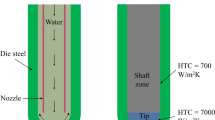Abstract
This study was carried out to determine the parameters affecting the performance of ring-type air cooling channels used in low-pressure die casting method for aluminum wheel casting. The main purpose of this study is to reveal the working principles of air cooling used in wheel casting. The study was conducted using computational fluid dynamics software. Field verification was performed before different numerical experiments. Then, flow rate was measured with different numerical experiments by changing the number of cooling inlets, number of cooling outlets and cooling pressure of the cooling channel. Experiments with numerical methods were examined statistically. The results showed that the flow rate of the cooling air is affected by the inlet count, the pressure of the cooling channel and the ratio between the inlet and outlet areas. Cooling system would contain air pressure of 6 bar, maximum outlet count of 12 and inlet count of 2 for optimum cooling performance and effectiveness. Ai/Ao ratio was found as 0.5 for maximum mass flow to this cooling system.

















Similar content being viewed by others
References
J. Duan, C. Reilly, D.M. Maijer, S.L. Cockcroft, A.B. Phillion, IOP Conf. Ser. Mater. Sci. Eng. 84, 012036 (2015). https://doi.org/10.1088/1757-899x/84/1/012036
D. Sui, Z. Cui, R. Wang, S. Hao, Q. Han, Effect of cooling process on porosity in the aluminum alloy automotive wheel during low-pressure die casting. Int. J. Metalcast. 10(1), 32–42 (2015). https://doi.org/10.1007/s40962-015-0008-0
P.I. Manilal, D.P.K. Singh, Z.W. Chen, Computer modeling and experimentation for thermal control of dies in permanent mold casting, in Transactions American Foundrymens Society 111, pp. 125–136 (2003)
M. Ayabe, T. Nagaoka, K. Shibata, H. Nozute, H. Koyama, K. Ozaki, T. Yanagisawa, Effect of high thermal conductivity die steel in aluminum casting. Int. J. Metalcast. 2(2), 47–55 (2008). https://doi.org/10.1007/BF03355427
S. Li, D. Apelian, Int. J. Metalcast. 5(1), 23–40 (2011). https://doi.org/10.1007/BF03355505
J.G. Kaufman, E.L. Rooy, Aluminum Alloy Castings Properties: Properties, Processes and Applications, 1st edn. (ASM International, Materials Park, OH, 2004)
M. Shabani, A. Mazahery, Arch. Metall. Mater. 56(3), 671–675 (2011). https://doi.org/10.2478/v10172-011-0073-1
L. Zhang, Y. Jiang, Z. Ma, S. Shan, Y. Jia, C. Fan, W. Wang, J. Mater. Process. Techn. 207(1–3), 107–111 (2008). https://doi.org/10.1016/j.jmatprotec.2007.12.059
R. Chen, Y. Shi, Q. Xu, B. Liu, Trans. Nonferrous Metal. Soc. China 24(6), 1645–1652 (2014). https://doi.org/10.1016/S1003-6326(14)63236-2
M. Ayabe, T. Nagaoka, K. Shibata, H. Nozute, H. Koyama, K. Ozaki, T. Yanagisawa, Int. J. Metalcast. 2(2), 47–55 (2008). https://doi.org/10.1007/BF03355427
J.-I. Cho, C.-W. Kim, Int. J. Metalcast. 8(1), 49–55 (2014). https://doi.org/10.1007/BF03355571
W. Kasprzak, M. Sahoo, J. Sokolowski, H. Yamagata, H. Kurita, The effect of the melt temperature and the cooling rate on the microstructure of the Al-20% Si alloy used for monolithic engine blocks. Int. J. Metalcast. 3(3), 55–71 (2009). https://doi.org/10.1007/BF03355453
Y.S. Lerner, Mold life improvement in permanent mold casting, in 5th AFS International Conference on Permanent Mold Casting of Aluminum, pp. 81–94 (American Foundry Society, Des Plaines, IL, 2000)
A. Long, D. Thornhill, C. Armstrong, D. Watson, Stress correlation between instrumentation and simulation analysis of the die for high pressure die casting. Int. J. Metalcast. 7(2), 27–41 (2013). https://doi.org/10.1007/BF03355551
Y.S. Lerner, Water or air? Examining permanent mold cooling methods. Mod Cast 92(23), 26 (2002)
R.J.H. Lee, Effect of cooling circuit duration on formation of solidification shrinkage in A356 Casting automotive wheels (Scriptie, 2006). Retrieved from https://core.ac.uk/download/pdf/56360952.pdf
H. Kawahara, Chapter 29: Heat and Mass Transfer in Jet Type Mold Cooling Pipe, in Developments in Heat Transfer, ed. by M.A. dos Santos Bernardes (InTech, London, 2011), pp. 573–588
P.H. Oosthuizen, W.E. Carscallen, International Compress Fluid Flow (CRC Press, Florida, 2013)
K. Marzec, A. Kucaba-Pietal, J. Phys. Conf. Ser. 530, 012038 (2014). https://doi.org/10.1088/1742-6596/530/1/012038
M.L. Hosain, R. Bel Fdhila, A. Daneryd, Appl. Energy 164, 934–943 (2016). https://doi.org/10.1016/j.apenergy.2015.08.038
E. Karapetian, G. Aguilar, S. Kimel, E.J. Lavernia, J.S. Nelson, Phys. Med. Biol. 48(1), 1 (2002). https://doi.org/10.1088/0031-9155/48/1/401
M.T. Meyer, I. Mudawar, C.E. Boyack, C.A. Hale, Int. J. Heat Mass Transf. 49(1–2), 17–29 (2006). https://doi.org/10.1016/j.ijheatmasstransfer.2005.07.039
X. He, J.A. Lustbader, M. Arik, R. Sharma, Int. J. Heat Mass Transf. 80, 825–834 (2015). https://doi.org/10.1016/j.ijheatmasstransfer.2014.08.006
Y.A. Cengel, J.M. Cimbala, Fluid Mechanics Fundamentals and Applications (McGraw-Hill Education, New York, 2013)
X. Gao, R. Li, Spray impingement cooling: the state of the art. Adv Cool Technol Appl (2019). https://doi.org/10.5772/intechopen.80256
R. Dindorf, Estimating potential energy savings in compressed air systems. Proc. Eng. 39, 204–211 (2012). https://doi.org/10.1016/j.proeng.2012.07.026
R.E. Terrell, Improving compressed air system efficiency—know what you really need. Energy Eng. 96(1), 7–15 (1999). https://doi.org/10.1080/01998595.1999.10530444
F. Mazzelli, A.B. Little, S. Garimella, Y. Bartosiewicz, Int. J. Heat Fluid Flow 56, 305–316 (2015). https://doi.org/10.1016/j.ijheatfluidflow.2015.08.003
A. Hemidi, F. Henry, S. Leclaire, J. Seynhaeve, Y. Bartosiewicz, Appl. Therm. Eng. 29(8–9), 1523–1531 (2009). https://doi.org/10.1016/j.applthermaleng.2008.07.003
G. Besagni, F. Inzoli, Appl. Therm. Eng. 117, 122–144 (2017). https://doi.org/10.1016/j.applthermaleng.2017.02.011
S. Croquer, S. Poncet, Z. Aidoun, Int. J. Refrig. 61, 140–152 (2016). https://doi.org/10.1016/j.ijrefrig.2015.07.030
O. Caggese, G. Gnaegi, G. Hannema, A. Terzis, P. Ott, Int. J. Heat Mass Transf. 65, 873–882 (2013). https://doi.org/10.1016/j.ijheatmasstransfer.2013.06.043
S. Fechter, A. Terzis, P. Ott, B. Weigand, J. Von Wolfersdorf, M. Cochet, Int. J. Heat Mass Transf. 67, 1208–1219 (2013). https://doi.org/10.1016/j.ijheatmasstransfer.2013.09.003
Acknowledgements
We would like to express our appreciation to Eren Bozkurt for his help in validation study. We would also express that this article is produced from the studies in the Master’s thesis of Hakan Yavuz.
Author information
Authors and Affiliations
Corresponding author
Additional information
Publisher's Note
Springer Nature remains neutral with regard to jurisdictional claims in published maps and institutional affiliations.
Rights and permissions
About this article
Cite this article
Yavuz, H., Ertugrul, O. Numerical Analysis of the Cooling System Performance and Effectiveness in Aluminum Low-Pressure Die Casting. Inter Metalcast 15, 216–228 (2021). https://doi.org/10.1007/s40962-020-00446-x
Published:
Issue Date:
DOI: https://doi.org/10.1007/s40962-020-00446-x




